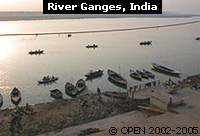British scientists put forward new theory for the origin of mad cow disease
In the latest issue of The Lancet, two UK scientists have proposed a new theory for the origin of 'mad cow disease', claiming that the first cases of bovine spongiform encephalopathy (BSE), may have been caused by infected human remains mixed into animal feed. The theory has been received with some scepticism by several experts on BSE as no sound evidence to support these theories has been found yet. The authors - Alan Colchester from the University of Kent and Nancy Colchester, from the University of Edinburgh - admit this point, but argue that their theory, based on circumstantial evidence, is plausible enough to warrant further investigation. The new theory consists of three hypotheses, that human transmissible spongiform encephalopathy (TSE)-contaminated material was the cause of BSE; that this was transmitted orally via animal feed; and that the infective material originated from the Indian subcontinent. The cause of the original case or cases of BSE is unknown, but it belongs to a class of fatal, untreatable TSEs that affect several species. A handful of TSEs are found in humans, including Kuru, Alper's disease and Creutzfeldt-Jakob disease, or CJD. The disease was not known to infect cows until 1986, when the first cases were noticed in Britain. About a decade later, a new permutation of CJD, which scientists dubbed 'variant CJD', started showing up in people there. Experts believe this new variant came from eating beef products infected with mad cow disease, but exactly how cows first became infected remains an enigma. The most popular theory is that cattle, which are vegetarian, were fed meal containing sheep remains, passing scrapie from sheep to cows, where it eventually evolved into a cow-specific disease. The Colchesters point out that cows have been exposed to scrapie for 70 years, so it is hard to explain why BSE emerged only recently. They think that a more likely source is recent exposure to human remains carrying sporadic Creutzfeldt-Jakob Disease (CJD), a TSE thought to arise spontaneously in people. Another theory is that cows just developed the disease spontaneously, without catching it from another species. Britain imported hundreds of thousands of tons of whole bones, crushed bones and carcass parts from Bangladesh, India and Pakistan to be used for fertilizer and animal feed during the 1960s and 1970s. 'In India and Pakistan, gathering large bones and carcasses from the land and from rivers has long been an important local trade for peasants,' explain the scientists. 'Collectors encounter considerable quantities of human as well as animal remains as a result of religious customs.' Hindus believe remains should be disposed of in a river, preferably the Ganges. Even though the ideal method is for the body to be burned first, most people cannot afford enough wood for a full cremation, and many complete corpses are thrown into the river. According to the scientists, the inclusion of human remains in animal bone material exported from the Indian subcontinent during this has been previously documented. Britain was the main recipient of animal by-products exported from India and Pakistan during the relevant period, and was also a leader in feeding meat and bone meal to calves, they noted. For the scientists, the similarities between the strains - mad cow disease, classical CJD and variant CJD - are sufficiently close to support the theory of a link between them. 'We do not claim that our theory is proved, but it unquestionably warrants further investigation,' conclude the authors.
Countries
United Kingdom



